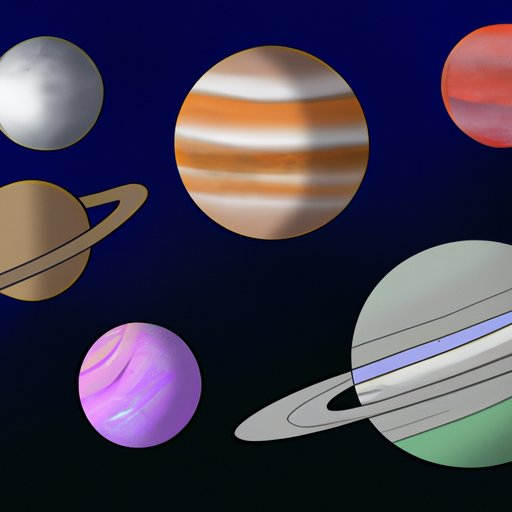Introduction
Gas giants are a type of planet that are known for their large size, gaseous composition, and unique features. These planets, which include Jupiter, Saturn, Uranus, and Neptune, are different from other planets in our solar system and beyond in many ways. In this article, we’ll explore what makes gas giants so fascinating, including their composition, unique features, and potential for hosting life beyond Earth.
Exploring the Giant Planets: What Makes Jupiter and Saturn So Different?
Gas giants are known for their unique features, which make them quite different from terrestrial planets like Earth. For one, gas giants are much larger than their rocky counterparts, with thick atmospheres of hydrogen, helium, and other gases. They also don’t have solid surfaces to stand on, meaning that their interiors are under immense pressure due to gravitational forces.
Two of the most well-known gas giants in our solar system are Jupiter and Saturn. These planets are known for their impressive rings, large size, and fascinating moons. Jupiter, for example, is the largest planet in our solar system and has a famous feature known as the Great Red Spot, which is a massive storm that has been swirling for over 350 years. Saturn is known for its stunning ring system, which is made up of particles of ice and rock that orbit around the planet.
What is a Gas Giant and Why is it Different from Other Planets?
Gas giants are composed primarily of hydrogen and helium, which make up most of their mass. They also have thick atmospheres that can contain a variety of other gases, such as methane, ammonia, and water vapor. Because of their composition, gas giants have certain unique characteristics, such as rapid rotation (which can lead to strong storms) and high internal pressure.
Gas giants are also different from other types of planets in our solar system, such as terrestrial planets like Mars and Venus. Terrestrial planets are much smaller than gas giants and have solid surfaces. They are also composed of heavier elements, such as iron and nickel. These fundamental differences make gas giants a unique type of planet in our universe.
The Mystery of Uranus and Neptune: The Lesser-Known Gas Giants
When people think of gas giants, Jupiter and Saturn are often the first planets that come to mind. However, there are two other gas giants in our solar system that are worth exploring: Uranus and Neptune. These planets are often called “ice giants” because they contain much larger amounts of heavier elements than Jupiter and Saturn. They also have unique characteristics, such as their diamond rain and irregular magnetic fields.
Despite their interesting features, Uranus and Neptune are much less well-known than the other gas giants in our solar system. This could be due to their more distant positions from Earth, or the fact that they haven’t been visited by a spacecraft since Voyager 2 flew by in the 1980s.
The Hunt for Exoplanet Gas Giants: What We’ve Discovered So Far
In recent decades, astronomers have made many interesting discoveries of gas giants outside of our solar system, also known as exoplanets. These planets are often much larger than those in our own solar system and can orbit much closer to their star. Detecting exoplanets is a difficult process, but there are a few methods that have been successful: the radial velocity method, the transit method, and the direct imaging method.
Some interesting discoveries have been made using these detection methods. For example, scientists have found exoplanets that are so close to their stars that their atmospheres are being boiled off into space. They have also discovered planets that have massive rings systems or are tidally locked to their star, meaning that one side of the planet is always facing the star.
Jupiter: Our Solar System’s King of the Gas Giants
Of all the gas giants in our solar system, Jupiter is perhaps the most well-known. It is the largest planet in our solar system by far, with a diameter of over 86,000 miles. Jupiter also has a powerful magnetic field that is 20,000 times stronger than Earth’s. This field is responsible for creating intense radiation belts around the planet, which can be harmful to spacecraft that come too close.
Jupiter also has several interesting features, such as the Great Red Spot and over 70 known moons. One of these moons, Europa, is of particular interest to scientists because it is believed to have a subsurface ocean that could potentially support life.
Gas Giants and the Search for Life Beyond Earth
When it comes to the search for extraterrestrial life, gas giants and their moons may not be the first places that come to mind. However, recent research has shown that some moons of gas giants could have the right conditions to support life, particularly if they have subsurface oceans.
One example of this is Europa, the moon of Jupiter that we mentioned earlier. Scientists believe that Europa may have a subsurface ocean that is in contact with the moon’s rocky mantle, creating conditions that could support life. Other moons that could potentially support life include Enceladus, a moon of Saturn, and Titan, another moon of Saturn that has a thick atmosphere and liquid lakes on its surface.
Conclusion
Gas giants are a fascinating type of planet that have captured the imagination of scientists and the public alike. From the impressive rings of Saturn to the potential for life on moons like Europa, gas giants offer a wealth of interesting research opportunities. By studying gas giants, we can gain a greater understanding of the universe and our place in it, and perhaps even discover new forms of life beyond Earth.
